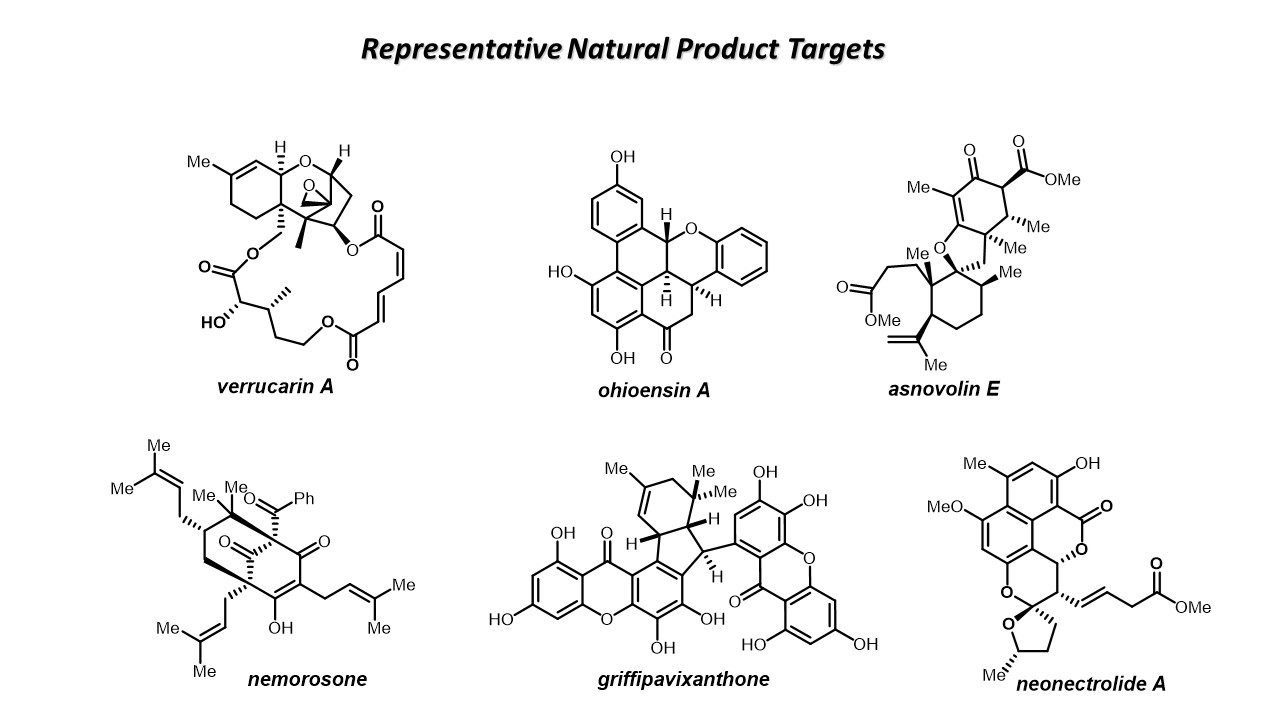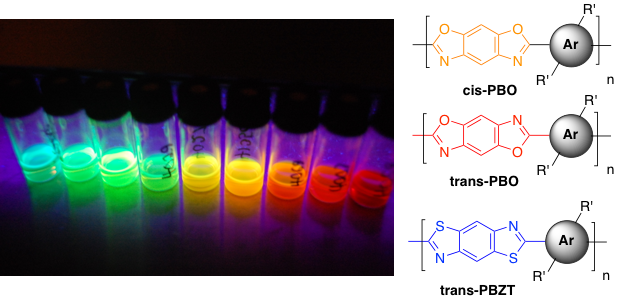Mark Grinstaff: The Design and Synthesis of Smart Materials
- Mark Grinstaff
- The Grinstaff Group pursues highly interdisciplinary research in the areas of biological and macromolecular chemistry. The major goal in these research projects is to elucidate the underlying fundamental chemistry and engineering principles and to use that insight to direct our creative and scientific efforts.
- We are designing, synthesizing, and characterizing novel dendrimers, termed “biodendrimers,” for tissue engineering and biotechnological applications. Currently, we are evaluating these novel biomaterials for the repair of corneal lacerations, for the delivery of anti-cancer drugs, for the delivery of DNA, and as temporary biodegradable scaffolds for cartilage repair.
- We are creating novel polymeric coatings termed “interfacial biomaterials” that control biology on plastic, metal, and ceramic surfaces.
- We are designing electrochemical-based sensors/devices using conducting polymer nanostructures and specific DNA structural motifs.
- The REU will join one of these projects utilizing the techniques of organic synthesis to prepare smart materials for various applications.
-

John Porco: Synthesis of Bioactive Complex Molecules
- John Porco
- The Porco Laboratory (https://www.porcogroup.com/; Twitter: @porco_lab ) develops new synthetic methodologies for efficient chemical synthesis of bioactive molecules and complex natural products. The laboratory also seeks to establish innovation in collaborative, translational science to study the biological properties and mode of action (MoA) of target molecules. We are highly interfaced with the nearby Boston University Center for Molecular Discovery (BU-CMD) which is located on the 8th floor of the LSE building. http://www.bu.edu/cmd/) as well as the newly establish BU Target Discovery Lab (BU-TDL, https://www.bu.edu/tdl/). Synthetic methodologies developed by the Porco group include: copper (I)-mediated formation of enamides, oxa-electrocyclization/dimerization of dienals enroute to complex epoxyquinoid frameworks; enantioselective oxidative dearomatization using chiral copper complexes and molecular oxygen; photocycloaddition using oxidopyryliums enroute to the rocaglamides and related natural products, catalytic ester-amide exchange using group (IV) metal alkoxide-activator complexes, and silver nanoparticle-catalyzed [4+2] cycloadditions. In the past 23 years, the Porco Group has synthesized a numerous ber of complex natural product targets including molecules with potent anticancer activity such as silvestrol, kibdelone C, secalonic acids, griffipavixanthone, and kinamycin C.
-

Scott Schaus: Discovery and Development of Medicinally Important Compounds
- Scott Schaus
- Professor Scott E. Schaus, Ph.D., is an Associate Professor in the Department of Chemistry at Boston University with concurrent appointments in the Bioinformatics Program, the Department of Pharmacology, and the Department Molecular Biology, Cell Biology and Biochemistry. Professor Schaus is also a co-PI for the Center for Molecular Discovery at BU. He received his Ph.D. in Organic Chemistry with Eric N. Jacobsen at Harvard University in 1999 and did postdoctoral studies at Harvard University as an NIH fellow. His research group concentrates on organic synthesis drawing mainly from catalytic methodologies as a source of selective transformations. Active projects in his group include the synthesis of small molecules that target cell cycle regulation, cell proliferation, and cell death. The Schaus group also employs genomic methodologies and analysis of mammalian cells to validate drug targets and cellular response mechanisms. Biological areas of research include oncology, virology, and infectious disease.
-

Aaron Beeler: New Paradigms in Drug Discovery
- Aaron Beeler
- The Beeler Research Group is truly multidisciplinary, combining organic chemistry, engineering, and biology to solve problems in medicinal chemistry. Focused medicinal chemistry projects utilize synthetic organic chemistry to address goals such as: a) developing a probe that may be utilized as a tool in biological studies; b) developing a lead molecule to facilitate future therapeutics; and c) utilizing small molecules to enhance understanding of biological targets. More broad impact research aims to develop new paradigms in medicinal chemistry through technology such as microfluidics. With this collaborative, multidisciplinary approach we are working to address significant problems in human health such as cancer, schizophrenia, Parkinson’s, and cystic fibrosis.
-

Arturo Vegas: Molecular Frontiers in Drug Discovery
- Arturo Vegas
- The Vegas group pursues general and systematic approaches to developing targeted therapeutic carriers for the treatment of multiple human diseases. Small-molecule drugs excel at altering disease states at the cellular level, but their therapeutic benefits are often hindered by physiological barriers that impact their toxicity, efficacy, and distribution. The ability to overcome these barriers can make major differences in both the safety and effectiveness of a therapeutic. Projects in the lab are focused on developing novel chemical tools, materials and approaches for targeting therapeutics to diseased tissues, with an emphasis on cancer and diabetes. These new tools will facilitate studies in the lab to understand mechanisms that control the physiological distribution of therapeutics and informing future targeting element design. For cancer, the primary focus will be developing conjugate and nanoparticle based approaches that control the physiological distribution and uptake of therapeutic molecules to tumors and the use of biomaterials to manipulate the tumor microenvironment. For diabetes, our focus will be selective destruction or functional blocking of cells responsible for the underlying type 1 autoimmunity. REU students in the lab will implement synthetic methods to create, purify, and characterize novel targeting moieties and materials and link them to payloads with therapeutic value or potential. These constructs will then be evaluated at the protein and cellular levels, with lead constructs being advanced into animal studies. Techniques, methods, and approaches from organic synthesis, chemical biology, materials science, and biomedical engineering will be integrated to address these challenging problems in drug delivery.
-

Malika Jeffries-EL: Design and Synthesis of Novel Organic Heterocycles for use in Advanced Applications
- Malika Jeffries-EL
- Organic semiconductors are a unique class of materials that combine the processability of organic materials with the optical and electronic properties of semiconductors. These complex materials impact several areas of technological importance including energy (solar cells), displays, (light emitting diodes), electronics (field effect transistors), and health (sensors). These carbon-based small molecules, oligomers or polymers were initially envisioned as replacements for silicon and rare-earth metals based semiconductors widely used today. However, organic materials can be used to create devices with properties that are unachievable using inorganic materials, such as color tuning and fabrication on irregular surfaces. At it core, research in this field is based on the synthesis of substitiuted aromatic and heteroaromatic molecules. The REU student will develop new organic synthetic methodology for the preparation of aromatic compounds. The interdisciplinary nature of my work makes it an excellent venue for exposure to a broad range of potential fields of study.
-

Lauren Brown: Medicinal Chemistry
- Lauren Brown
- The overall theme of our research program is to deploy chemical synthesis and medicinal chemistry, while also leveraging structural biology and computational tools, to develop new therapies for challenging human diseases. Of particular interest is the discovery of new treatments for infectious diseases, including those caused by fungi (cryptococcal meningitis), viruses (smallpox), and parasites (malaria and leishmaniasis). Student trainees in the BU-CMD get broad exposure to the art of organic chemistry, learning how to construct molecules (chemical synthesis), and the design principles and strategies that are inherent to improving the biological activity and “druglikeness” of an active molecule class (medicinal chemistry). Students also gain direct exposure to the downstream utility of the molecules they produce, which are provided to our collaborators in biology and medicine to test against targets of interest.
John Snyder: The Discovery of New Synthetic Methodology for the Delopment of Biologically Active Small Molecule Libraries
- John Snyder
- The discovery of new drug candidates and biological probes begins with the discovery of new chemistry, leading to new compounds of unusual structure, rich in stereochemistry, that go beyond what nature can manufacture. In several projects our group focuses on the discovery of new chemistries for the synthesis of natural product-like scaffolds that can be exploited in the preparation of small molecule libraries. An example is the preparation of a series of tetrahydro-1,6-naphthyridines such as 1 which have shown anti-tuberculoid activity. Another series of heterocycles represented by 2 was discovered to be active against hepatitis C virus. Other projects begin with readily available natural products as scaffolds for remodellig to new chemotypes sich as 3. The REU student will develop new organic synthetic methodology for the discovery of new biological active compounds. In the course of this research, the scope of the chemistry will be expanded with a greater variety of co-reactants to create a small molecule library. Once prepared, these libraries will be submitted for bioactivity screening through various biological collaborators.
-







